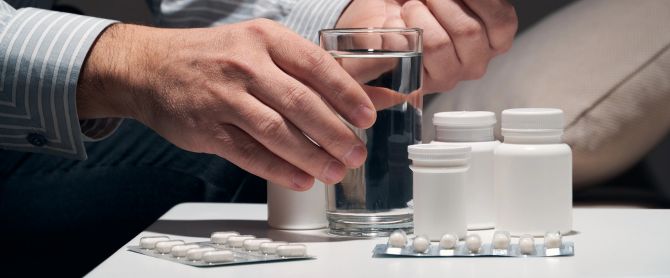Tramadol is often prescribed to treat moderate to severe pain. However, it has a potential for addiction. Over time, misuse can lead to physical and psychological addiction that requires structured tramadol detox.
Questions Answered in This Article:
- Tramadol Addiction Risks
- Effects Of Tramadol Abuse
- Tramadol Misuse In The U.S.
- Why Tramadol Withdrawal Happens
- Managing Tramadol Withdrawal Symptoms Safely
- What To Expect During The Detox Timeline
Is Tramadol addiction affecting your life?
Take the first step today and connect with a detox program.
Tramadol Addiction Risks
Tramadol is an opioid pain relief medication that affects serotonin and norepinephrine in the brain. This synthetic opioid may seem less dangerous than stronger fast acting opioids such as oxycodone or fentanyl. However, repeated use can quickly lead to dependence.
The risk of addiction comes from the way Tramadol alters brain chemistry. The opioid drugs create both physical cravings and emotional reliance. Thus, some people may increase their dosage or use Tramadol outside of medical guidance. This raises the risk of dependence.
Recognizing that “weaker opioids” can still cause severe addiction is crucial to protecting your health.
Causes of Tramadol Addiction
Tramadol addiction begins with a legitimate prescription for pain. However, there exists a potential for abuse. Tramadol misuse is most likely even patients without a history of substance abuse.
How to Recognize the Signs of Tramadol Addiction
The signs of addiction may include taking a higher dose of tramadol than prescribed. Obsessing over refills, or “doctor shopping” for multiple prescriptions are also red flags. Physical symptoms like sweating, nausea, and fatigue may accompany psychological changes such as anxiety, irritability, and depression.
Behavioral changes, such as withdrawing from loved ones or losing interest in daily responsibilities, are also red flags. The sooner you identify these warning signs, the faster you can intervene with safe and effective treatment.
Are you worried about your use of Tramadol?
Talk to a professional today to evaluate safe detox options.
Effects of Tramadol Abuse
Tramadol misuse has short-term side effects such as dizziness, nausea, and sedation. But it can also produce dangerous outcomes such as anxiety panic, seizures or respiratory issues. Over time, the drug may cause significant damage to the liver, kidneys, and nervous system.
Prolonged use can also affect mental health. Long-term Tramadol use also contributes to mental health conditions such as depression, anxiety, and cognitive impairment. The longer misuse continues, the greater the risk of irreversible health consequences.
Don’t ignore the warning signs of Tramadol addiction.
Safe detox can prevent long-term damage.
Tramadol Misuse in the U.S.
The misuse of Tramadol has grown steadily in the United States. Prescription rates nearly doubled between 2008 and 2013.
The misuse of Tramadol has grown steadily in the United States. Prescription rates nearly doubled between 2008 and 2013.
Synthetic opioids, including Tramadol, have increasingly contributed to overdose deaths. From 2003 to 2021, overdose death rates climbed from around 0.5 per 100,000 to 21.8 per 100,000 and 22.2 per 100,000 in 2023.
The drug enforcement administration notes these rising numbers highlight how easily Tramadol misuse can spiral into dependence. Understanding these risks makes seeking safe Tramadol detox and professional support more urgent than ever.”
Are you or someone you love misusing Tramadol?
Professional detox is the safest path forward.
Why Tramadol Withdrawal Happens
When Tramadol is taken regularly, the brain adjusts to its presence. Stopping suddenly causes a chemical imbalance. This leads to Tramadol withdrawal. These symptoms can range from mild discomfort to severe cravings and mood swings.
Tramadol withdrawal treatment provides structure and support to help in tramadol withdrawal management. Going through withdrawal under medical supervision greatly reduces the risk of relapse.
Symptoms of Tramadol Withdrawal
Stopping Tramadol suddenly can lead to opioid withdrawal symptoms such as insomnia, irritability, flu-like discomfort, and anxiety. Because Tramadol also affects serotonin, some users may experience mood swings, depression, or unusual neurological symptoms during withdrawal.
Medical tramadol addiction detox helps manage these symptoms in a safe, supportive environment. Attempting detox at home without guidance can be dangerous. But supervised withdrawal provides stability and care.
Common withdrawal symptoms include:
- Restlessness and anxiety
- Headaches or dizziness
- Stomach upset, nausea, or vomiting
- Muscle and joint pain
- Sweating, chills, or fever-like symptoms
- Insomnia or disturbed sleep
- Depression and irritability
- Strong cravings for the drug
Because of these challenges, relapse is common without professional help. Structured detox provides safer ways to ease these symptoms.
Don’t let withdrawal symptoms stand between you and recovery.
Consider a supervised Tramadol detox program.
Managing Tramadol Withdrawal Symptoms Safely
Detoxing at home may seem appealing. However, it carries significant risks and can quickly become unmanageable. It makes relapse more likely.
Medical detox for tramadol programs in a treatment center offers a safer alternative. It provides professional monitoring, medications to ease discomfort, and access to counseling. Thus, patients can navigate withdrawal with less risk.
Safe detox from Tramadol is about more than quitting the drug. It includes medical monitoring, symptom management, and sometimes medication-assisted treatment (MAT).
Therapies like counseling, behavioral therapy, and peer support help address the psychological aspects of addiction. Detox is the beginning, but a treatment program ensures a strong foundation for long term recovery.
Explore your Tramadol addiction treatment options.
Contact a detox center to find the program that works best for your needs.
What to Expect During the Detox Timeline
Withdrawal symptoms usually begin within 8–12 hours after the last dose of Tramadol. The worst phase typically occurs during the first few days, with symptoms peaking around days 2–3.
While physical discomfort often improves within a week, cravings and emotional struggles may linger for weeks or months. This is why aftercare and ongoing treatment are critical for long-term success.
Treatment Beyond Detox
While detox helps clear Tramadol from the body, recovery doesn’t stop there. Without continued care, relapse is highly likely. Treatment programs build the skills needed to live drug-free.
Options include inpatient rehab, outpatient counseling, group therapy, and medication-assisted treatment (MAT). These approaches address the emotional and psychological side of addiction, not just the physical dependence.
Start your full recovery journey.
Explore treatment programs that provide long-term support and relapse prevention.
Your Path to Healing Begins at Scottsdale Detox
Tramadol addiction can take a serious toll on your body, mind, and quality of life. Recovery is possible for anyone ready to take that step.
The journey may feel overwhelming at first. But professional guidance can ease the process and open the door to a healthier, drug-free future. You don’t have to face it alone—help is available.
Scottsdale Detox in Scottsdale, Arizona offers medically supervised Tramadol detox programs. Our detox programs ease withdrawal symptoms, reduce risks, and help you take the first step toward long-term sobriety. With compassionate care and proven treatment methods, you don’t have to face this journey alone.
If you or a loved one is struggling with Tramadol dependence, now is the time to act. Contact Scottsdale Detox today to learn more about our detox programs, personalized therapies, and aftercare support. Together, we’ll help you build a healthier, drug-free future and reclaim the life you deserve.






